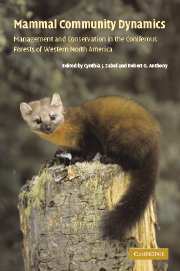 Mammal Community Dynamics
Mammal Community Dynamics Book contents
- Frontmatter
- Contents
- List of contributors
- Foreword
- Acknowledgments
- Part I Management and conservation issues for various taxa
- 1 Introduction and historical perspective
- 2 Forests and woodlands of western North America
- 3 Faunal composition and distribution of mammals in western coniferous forests
- 4 Habitat ecology and conservation of bats in western coniferous forests
- 5 Ecological relationships of terrestrial small mammals in western coniferous forests
- 6 Ecology and conservation of arboreal rodents of western coniferous forests
- 7 Small and mid-sized carnivores
- 8 Ecology, conservation, and restoration of large carnivores in western North America
- 9 Ungulates in western coniferous forests: habitat relationships, population dynamics, and ecosystem processes
- Part II Community and ecosystem relations
- Part III Conservation issues and strategies
- Index
- References
5 - Ecological relationships of terrestrial small mammals in western coniferous forests
Published online by Cambridge University Press: 15 December 2009
- Frontmatter
- Contents
- List of contributors
- Foreword
- Acknowledgments
- Part I Management and conservation issues for various taxa
- 1 Introduction and historical perspective
- 2 Forests and woodlands of western North America
- 3 Faunal composition and distribution of mammals in western coniferous forests
- 4 Habitat ecology and conservation of bats in western coniferous forests
- 5 Ecological relationships of terrestrial small mammals in western coniferous forests
- 6 Ecology and conservation of arboreal rodents of western coniferous forests
- 7 Small and mid-sized carnivores
- 8 Ecology, conservation, and restoration of large carnivores in western North America
- 9 Ungulates in western coniferous forests: habitat relationships, population dynamics, and ecosystem processes
- Part II Community and ecosystem relations
- Part III Conservation issues and strategies
- Index
- References
Summary
Small mammals are important components of western forest ecosystems. Their interactions with other organisms and the physical environment are complex. Small mammals are effective predators on seeds, vegetation, and insects, and may influence patterns of forest regeneration (Sullivan 1979, Christy and Mack 1984). Dispersal of seeds, mycorrhizal fungi, and nitrogen-fixing bacteria by small mammals may also affect plant diversity (Maser et al. 1978, Verts and Carraway 1998, Luoma et al. 2003). In addition, small mammals are prey for many carnivorous taxa, and changes in small-mammal abundance may affect the distribution and habitat use of their predators (Carey et al. 1992).
Understanding patterns of abundance and distribution of small mammals and how these species influence forest function and biodiversity are basic ecological problems relevant to both economic and conservation concerns. Exploration of these fundamental ecological relationships is challenging, however, because of the secretive nature of small mammals and their activities at night (e.g., deer mice (Peromyscus spp.)), below ground (e.g., gophers (Thomomys spp.) and moles (Scalopus spp.)), at the soil–vegetation interface (e.g., red-backed voles (Clethrionomys spp.) and shrews (Sorex spp.)), and in all levels of the canopy (e.g., flying squirrels (Glaucomys spp.) and tree squirrels (Tamiasciurus spp.)) (Aubry et al. 2003). In this chapter, we emphasize the forest-floor fauna, although not all species discussed confine themselves to the ground stratum (e.g., chipmunks (Tamias spp.) and woodrats (Neotoma spp.)).
- Type
- Chapter
- Information
- Mammal Community DynamicsManagement and Conservation in the Coniferous Forests of Western North America, pp. 120 - 156Publisher: Cambridge University PressPrint publication year: 2003
References
- 10
- Cited by


